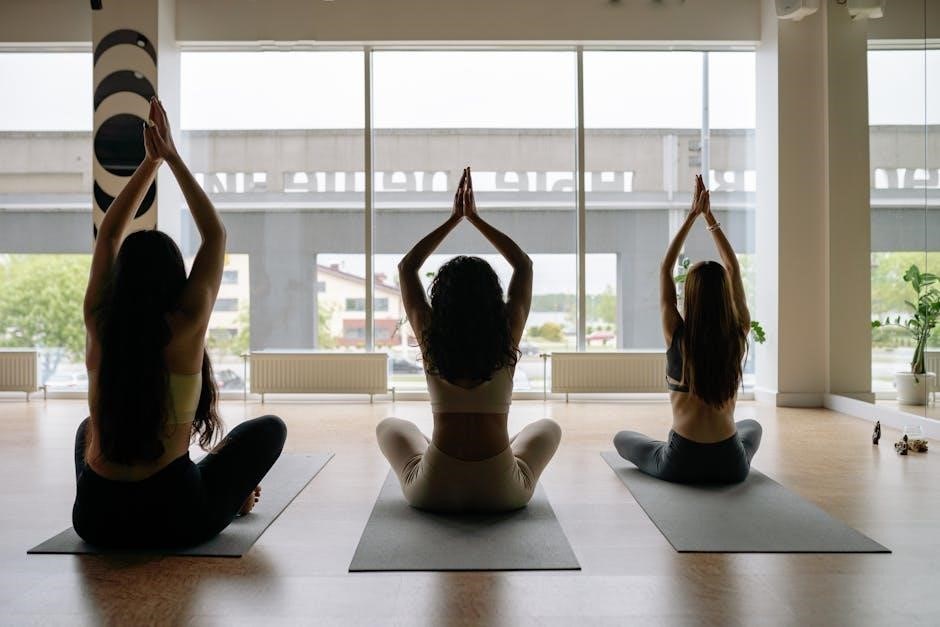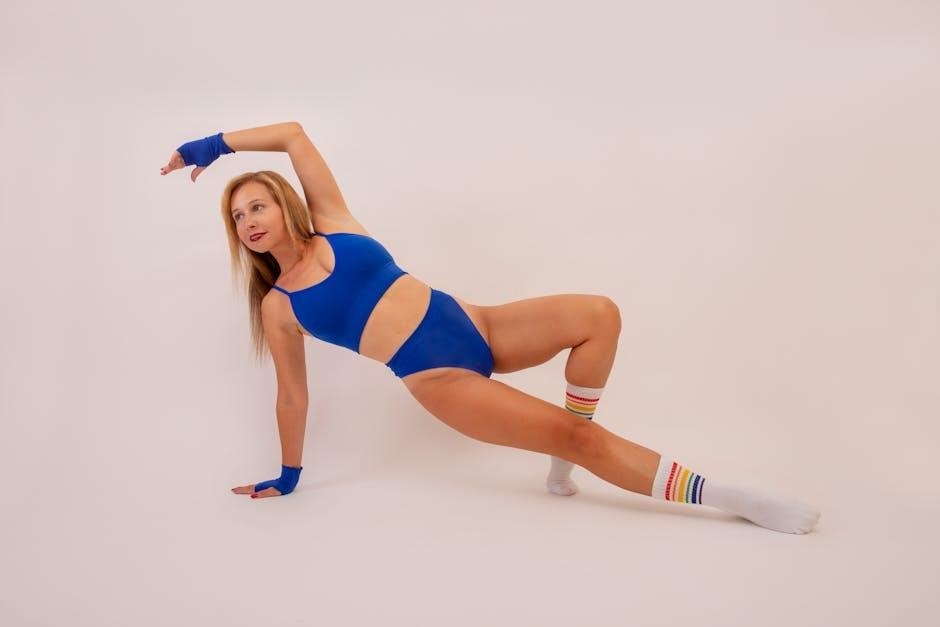Somatic yoga blends traditional yoga poses with somatic movement principles, emphasizing body awareness, gentle movements, and breath integration․ This practice promotes relaxation, flexibility, and overall well-being, making it accessible to all levels․
Overview of Somatic Yoga and Its Benefits
Somatic yoga is a holistic practice that combines gentle, mindful movements with traditional yoga poses to enhance body awareness and promote relaxation․ By focusing on internal sensations and breath, it helps release tension, improve flexibility, and strengthen the mind-body connection․ This approach is particularly beneficial for individuals seeking stress relief, chronic pain management, and improved mobility․ Unlike traditional yoga, somatic yoga emphasizes slow, intentional movements rather than achieving perfect postures, making it accessible to all levels․ Regular practice fosters self-awareness, reduces muscle stiffness, and enhances overall well-being․ Its therapeutic benefits make it an ideal choice for those with injuries, limited mobility, or chronic conditions, offering a path to healing and balance․
Importance of Somatic Yoga in Modern Wellness
Importance of Somatic Yoga in Modern Wellness
Somatic yoga plays a vital role in modern wellness by offering a holistic approach to physical and mental health․ Its focus on body awareness, gentle movements, and breathwork makes it an ideal practice for managing stress, chronic pain, and limited mobility․ In today’s fast-paced world, somatic yoga provides a therapeutic outlet to release tension and improve flexibility․ It is particularly beneficial for individuals seeking to enhance their mind-body connection and cultivate self-awareness․ By prioritizing internal sensations over external forms, somatic yoga fosters a compassionate and adaptive practice that suits diverse needs․ Its accessibility and therapeutic benefits make it a valuable tool for promoting overall well-being in contemporary lifestyles․

Understanding Somatic Yoga
Somatic yoga combines traditional yoga poses with somatic principles, focusing on body awareness, gentle movements, and breath integration․ It emphasizes internal sensations, fostering a therapeutic, adaptive practice for all levels․
Definition and History of Somatic Yoga
Somatic yoga is a holistic practice blending traditional yoga poses with somatic movement principles․ It focuses on internal body awareness, slow movements, and breath integration to release tension and enhance well-being․ Rooted in yoga’s ancient wisdom, somatic yoga evolved to incorporate modern somatic therapies, emphasizing a therapeutic approach․ It encourages listening to the body’s internal cues, fostering self-compassion and acceptance․ Unlike traditional yoga, which often focuses on achieving specific postures, somatic yoga prioritizes the internal experience, making it accessible to all, regardless of physical limitations․ Its history draws from yoga’s philosophical foundations and the somatic movement’s focus on body awareness, creating a unique, adaptive practice for modern wellness․
Key Principles of Somatic Movement
Somatic movement is rooted in mindful, slow, and intentional actions that prioritize internal body awareness․ It emphasizes listening to the body’s sensations, fostering a deep connection between mind and body․ Key principles include gentle, deliberate movements, prolonged holds in poses to release tension, and breath integration to guide actions․ The practice encourages self-compassion, accepting the body’s limitations, and avoiding forceful postures․ It focuses on internal experience over external form, making it accessible to all levels, including those with injuries or limited mobility․ By cultivating awareness and releasing chronic muscle tension, somatic movement promotes relaxation, flexibility, and overall well-being, serving as a therapeutic approach to mindful living․

Benefits of Somatic Yoga
Somatic yoga enhances flexibility, strength, and body awareness while offering pain relief, stress reduction, and improved mind-body connection, making it accessible and transformative for all practitioners․
Physical Benefits: Flexibility, Strength, and Pain Relief
Somatic yoga improves flexibility by releasing tension through gentle, mindful movements․ It strengthens muscles without strain, enhancing overall physical resilience․ The practice offers therapeutic benefits for chronic pain and injuries by targeting specific areas of tension, promoting relaxation and ease․ Prolonged holds in poses allow for deep release, reducing discomfort and improving mobility․ Adaptability is key, with modifications and props ensuring accessibility for all bodies․ Regular practice fosters better posture and alignment, while slow, intentional movements prevent overexertion․ This approach makes somatic yoga an effective tool for enhancing physical well-being and managing pain, regardless of fitness level or prior experience․
Mental and Emotional Benefits: Stress Reduction and Mindfulness
Somatic yoga cultivates mindfulness and reduces stress by focusing on slow, intentional movements and breath awareness․ The practice calms the nervous system, alleviating anxiety and tension․ By fostering a deeper connection to internal sensations, it promotes self-compassion and emotional resilience․ Mindful movements encourage presence, helping to quiet the mind and reduce mental chatter․ The therapeutic nature of somatic yoga supports emotional well-being, offering a safe space for self-reflection and relaxation․ Regular practice enhances mental clarity, emotional regulation, and overall psychological health, making it a powerful tool for managing stress and fostering inner peace․ This introspective approach nurtures a balanced and harmonious state of mind, complementing physical benefits with profound emotional healing;
Enhanced Body Awareness and Mind-Body Connection
Somatic yoga enhances body awareness by encouraging practitioners to tune into internal sensations, fostering a deeper understanding of their physical and emotional states․ Through slow, deliberate movements and breath integration, individuals develop a heightened sense of proprioception, improving posture and movement efficiency․ This practice strengthens the mind-body connection, allowing for greater self-awareness and intuition․ By listening to the body’s cues, practitioners can identify and release tension, promoting fluidity and ease in movement․ The focus on internal feedback empowers individuals to honor their body’s limitations and capabilities, cultivating a more compassionate and attuned relationship with themselves․ This profound connection enhances overall well-being, supporting personal growth and holistic health․

Basic Somatic Yoga Poses
Basic somatic yoga poses include gentle stretches and foundational movements that promote body awareness, flexibility, and relaxation․ These poses are designed to enhance mind-body connection and improve overall well-being․
Foundational Poses for Beginners
Foundational somatic yoga poses are designed to introduce beginners to mindful movement and body awareness․ Start with the Three-Part Breath to cultivate relaxation and focus․ The Moving Bridge gently stretches the hips and lower back, while the Knee Rock with Cactus Arms releases tension in the spine․ The Half Wind Removing Pose improves spinal mobility, and Child’s Pose promotes deep relaxation․ These poses emphasize slow, deliberate movements and prolonged holds, allowing you to connect with your body’s sensations․ They are perfect for improving flexibility, releasing tension, and fostering a calm, centered state․ Listen to your body and modify as needed to ensure comfort and safety․
Intermediate Poses for Progression
Intermediate somatic yoga poses build on foundational movements, offering deeper challenges for strength, flexibility, and body awareness․ Practices include longer holds, intricate transitions, and extended ranges of motion․ Poses like deeper spinal twists or hip-opening sequences enhance mind-body connection․ Focus on maintaining proper alignment and breath integration for optimal benefits․ Listen to your body, modifying as needed to ensure safety and comfort․ These poses help improve posture, balance, and overall well-being while fostering a deeper understanding of your physical capabilities․ Progress gradually, emphasizing mindful movement over perfection, to safely advance your practice and enjoy the transformative power of somatic yoga․
Advanced Poses for Deepening Practice
Advanced somatic yoga poses offer a deeper exploration of body awareness and movement, suitable for experienced practitioners․ These poses often involve complex transitions, extended holds, and intricate sequences that integrate multiple stretches․ Practices may include refined spinal twists, dynamic hip-opening flows, and advanced breathing techniques to enhance therapeutic benefits․ Focus on controlled movements, mindful transitions, and prolonged holds to deepen relaxation and release tension․ Advanced poses require strength, flexibility, and body control, building on earlier foundations․ Seek guidance from a qualified instructor to refine techniques and ensure safety․ Prioritize mindful movement and breath integration to navigate challenging postures safely․ These practices foster a profound mind-body connection, advancing self-discovery and well-being․

Modifications and Props
Props like blocks, blankets, and straps are essential in somatic yoga for support and comfort․ They allow modifications to suit individual needs, ensuring safe and accessible practice for all levels․
Why Modifications Are Important
Modifications in somatic yoga are essential for ensuring a safe and accessible practice for all individuals․ They allow practitioners to adapt poses to their unique needs, whether due to injuries, limited mobility, or personal comfort levels․ By using props like blocks, blankets, or straps, individuals can support their bodies and maintain proper alignment without strain․ Modifications also enable deeper relaxation and awareness, fostering a more therapeutic experience․ This approach encourages self-compassion and acceptance, reminding us that yoga is not about achieving perfection but about honoring the body’s capabilities․ By prioritizing modifications, somatic yoga becomes a inclusive and transformative practice for everyone, regardless of fitness level or physical condition․
Using Props for Support and Comfort
Props play a vital role in somatic yoga by providing support and enhancing comfort during practice․ Items like blocks, blankets, bolsters, and straps allow practitioners to modify poses to suit their needs, ensuring safety and relaxation․ For example, a block can be placed under the sacrum in Bridge Pose for gentle support, while a blanket can cushion the spine during twisting poses․ Props help maintain proper alignment, reduce strain, and make poses more accessible, especially for those with injuries or limited mobility․ By incorporating props, individuals can deepen their practice, focus on breath, and cultivate a deeper mind-body connection․ This approach ensures that every pose is tailored to the practitioner’s comfort, fostering a therapeutic and inclusive experience․

Breathing Techniques in Somatic Yoga
Breath is central to somatic yoga, guiding mindful movement and enhancing body awareness․ Techniques like the Three-Part Breath promote relaxation, connecting the body and mind for deeper practice․
The Role of Breath in Somatic Practices
Breath plays a central role in somatic yoga, serving as a bridge between the body and mind․ It guides mindful movement, enhances relaxation, and deepens body awareness․ By focusing on breath, practitioners can release physical tension and emotional stress, fostering a calmer state of being․
Specific breathing techniques, such as the Three-Part Breath, are integral to somatic practices․ These techniques promote relaxation, improve circulation, and align movement with internal rhythms․ Breath awareness helps practitioners connect with their body’s sensations, making movements more intuitive and therapeutic․
In somatic yoga, breath is not just a tool for relaxation but a means to enhance the mind-body connection․ It allows practitioners to listen to their body’s needs, ensuring movements are safe and effective․ This mindful approach to breathing is what makes somatic yoga uniquely transformative, offering a holistic path to well-being․
Specific Breathing Exercises for Relaxation
Specific breathing exercises in somatic yoga are designed to promote deep relaxation and reduce stress․ The Three-Part Breath is a foundational technique, where breath is directed into the abdomen, chest, and collarbones, fostering mindfulness and calmness․ Another exercise is the 4-7-8 Breath, which involves inhaling for four counts, holding for seven, and exhaling for eight, promoting relaxation and reducing anxiety․
These exercises are often integrated into movements, such as the Moving Bridge or Cat-Cow, where breath guides the body through gentle stretches․ The focus is on slow, intentional breathing to release tension and enhance body awareness, creating a profound sense of calm and well-being․

Integrating Breath with Movement
Integrating breath with movement is a cornerstone of somatic yoga, enhancing body awareness and fostering a meditative flow․ By synchronizing breath with gentle, intentional movements, practitioners can release physical tension and promote deep relaxation․ The breath acts as a guide, helping to initiate, transition, and deepen poses, while also anchoring the mind in the present moment․
This harmonious union of breath and movement creates a therapeutic experience, improving circulation, reducing stress, and fostering a deeper mind-body connection․ Whether moving through flowing sequences or holding static poses, the breath serves as a bridge between physical and emotional release, allowing for a more profound and grounding practice․ This integration is adaptable to all levels, making it accessible and transformative for everyone․

Practicing Somatic Yoga for Specific Needs
Somatic yoga is tailored to address unique challenges, offering therapeutic benefits for trauma recovery, chronic pain management, and limited mobility․ Its adaptable nature ensures a safe, transformative experience for all․
Somatic Yoga for Trauma Recovery
Somatic yoga offers a therapeutic approach for trauma recovery, fostering a safe environment for healing․ By focusing on gentle, intuitive movements and breath awareness, it helps release stored tension and emotional blockages․ The practice encourages individuals to reconnect with their bodies, promoting a sense of control and empowerment․ Specific sequences are designed to address trauma-sensitive areas, allowing participants to explore their boundaries and release stress․ This mindful approach reduces triggers and promotes emotional resilience, offering a pathway to recovery and well-being․ Somatic yoga’s adaptability makes it accessible for trauma survivors, providing tools for self-regulation and stress reduction while fostering a deeper mind-body connection․
Somatic Yoga for Chronic Pain Management
Somatic yoga is a gentle, therapeutic practice that helps alleviate chronic pain by addressing the root causes of discomfort․ Through slow, intentional movements and breath awareness, it releases muscle tension and enhances flexibility; The practice focuses on improving circulation and reducing inflammation, which can provide long-term pain relief․ Somatic yoga also encourages a deeper connection to the body, allowing individuals to identify and release areas of chronic tension․ Its adaptability makes it suitable for those with limited mobility or persistent pain, offering a holistic approach to managing discomfort․ Regular practice can lead to improved posture, reduced pain episodes, and enhanced overall well-being, empowering individuals to take control of their chronic pain management․
Somatic Yoga for Limited Mobility
Somatic yoga is an ideal practice for individuals with limited mobility, offering gentle, adaptable movements that promote comfort and flexibility․ It emphasizes slow, intentional actions, allowing participants to work within their physical limitations․ The use of props, such as blocks, cushions, or blankets, provides support and enables safe exploration of poses․ Seated or lying-down postures are often utilized to accommodate mobility challenges, ensuring accessibility for all․ This practice focuses on enhancing body awareness, improving circulation, and releasing tension without strain․ By prioritizing comfort and mindful movement, somatic yoga helps reduce discomfort and fosters a deeper connection to the body, making it an excellent option for those with limited mobility to improve their well-being gently and effectively․

Challenging Somatic Yoga Poses
Advanced somatic yoga poses involve complex transitions, extended holds, and heightened focus on internal sensations․ These poses build on foundational movements, emphasizing strength, flexibility, and mindful breath integration for experienced practitioners․
Intermediate Poses for Strength and Flexibility

Intermediate somatic yoga poses build on foundational movements, introducing longer holds and more intricate transitions․ These poses enhance strength, flexibility, and body awareness while maintaining a focus on mindful movement․ Examples include deeper forward bends, twists, and balancing poses that require greater control and alignment․ Props like blocks or straps can be used to support the body and deepen the practice safely․ The emphasis remains on internal sensations, encouraging practitioners to explore their limits without forcing․ Breathing techniques are integrated to enhance relaxation and focus․ These poses are ideal for those seeking to progress their practice, fostering a deeper connection between mind and body while promoting overall well-being․
Advanced Poses for Experienced Practitioners
Advanced somatic yoga poses offer a deeper exploration of movement and body awareness, tailored for experienced practitioners․ These poses often involve complex transitions, extended holds, and a heightened focus on subtle internal sensations․ They aim to enhance strength, flexibility, and mind-body integration while maintaining a therapeutic approach․ Advanced practices may include intricate sequences, such as prolonged balancing poses or deeply releasing twists, designed to challenge both physical and mental limits․ Proper alignment and controlled breathing are crucial to maximize benefits and prevent injury․ Practitioners are encouraged to listen to their bodies and adapt poses as needed, ensuring a safe and transformative experience․ Advanced somatic yoga is a continuation of the journey toward self-discovery and holistic well-being;
Somatic yoga offers a transformative journey of self-discovery, enhancing body awareness and well-being․ For further learning, explore recommended resources, including detailed somatic yoga PDF guides and expert-led practices․
Final Thoughts on Somatic Yoga Practice
Somatic yoga is a powerful practice that fosters deep body awareness, relaxation, and mind-body connection․ By embracing slow, intentional movements and breathwork, it empowers individuals to release tension and enhance well-being․ Perfect for those seeking a therapeutic approach, it accommodates all levels, from beginners to advanced practitioners․ The practice encourages self-compassion, allowing you to honor your body’s unique needs․ With regular practice, somatic yoga can lead to improved posture, reduced pain, and a calmer mind․ It’s a journey of self-discovery and healing, offering tools to cultivate lasting physical and emotional balance․ Embrace the transformative potential of somatic yoga for a healthier, more mindful you․
Recommended Resources for Further Learning
For a deeper exploration of somatic yoga, consider downloading comprehensive PDF guides that detail poses, sequences, and breathing techniques․ Websites like NextYoga offer step-by-step instructions and modifications for all levels․ Additionally, online courses and workshops provide structured learning opportunities․ Books on somatic yoga, such as those focusing on trauma recovery, are invaluable for understanding the therapeutic benefits․ YouTube channels dedicated to somatic practices share video tutorials and tips for enhancing your practice․ Joining online communities or forums can connect you with experienced practitioners and instructors․ These resources will help you refine your technique, explore advanced poses, and integrate somatic yoga into your daily routine for lasting well-being․
